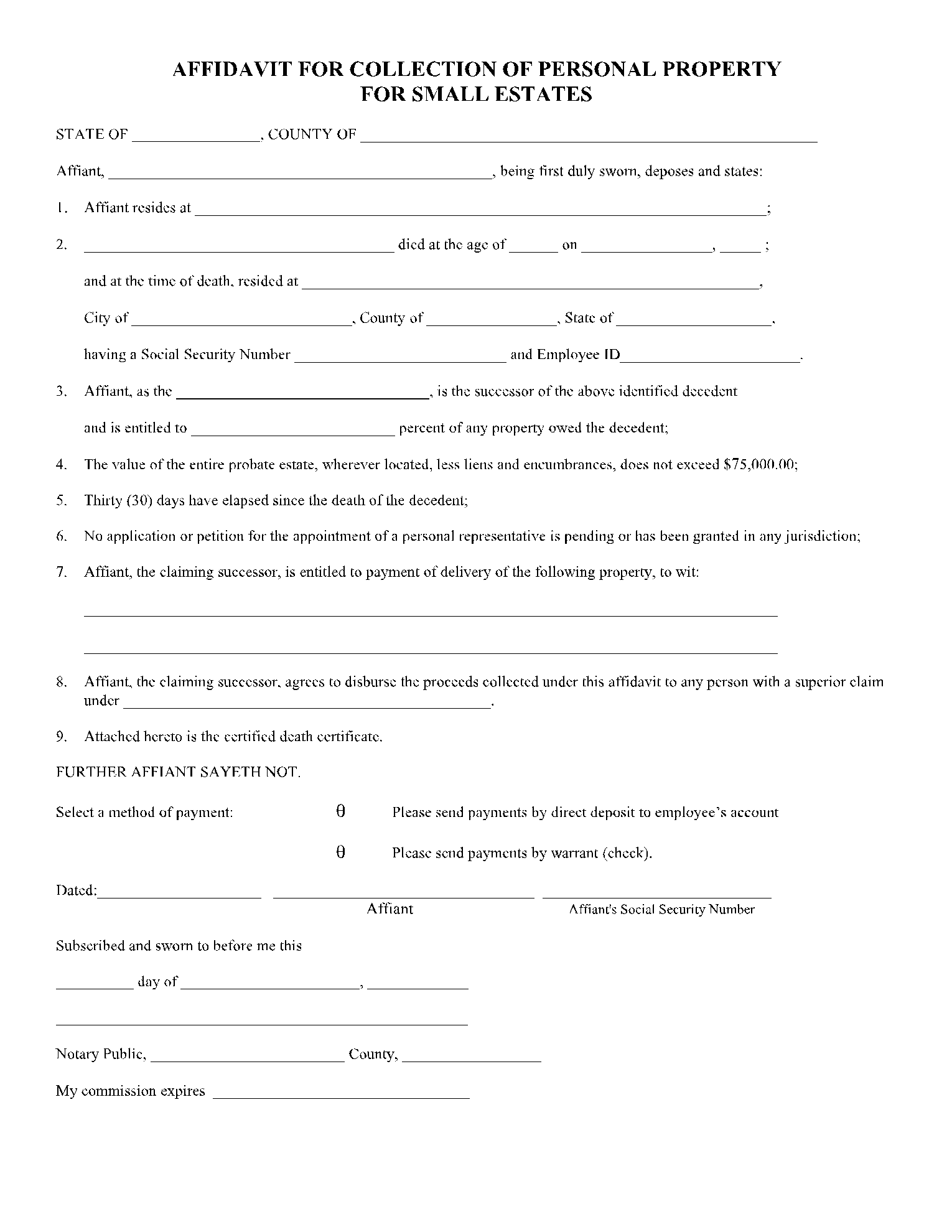You file a small estate affidavit aka “Affidavit for Collection of Personal Property” in California when you wish to inherit a deceased person’s small estate without lengthy probate. We explain such affidavits in detail in our how-to guide here. We also offer a free Affidavit for Collection of Personal Property template form above this article.
The following must be included in a California small estate affidavit
-
- Name of decedent
- Name and addresses o log successors
- Date of death
- Name of county in California
- Declaration of proceedings
- Appraisal of real property
- Intent of distribution property
What is a California Small Estate Affidavit?
The California small estate affidavit allows you – the filer – to inherit a small estate while skipping the usual probate of will process. The small estate affidavit allows you to collect property determined to be “small estate” in value only - up to $166, 250.
The small estate affidavit allows you to avoid the probate of will process, which is sometimes costly and time-consuming, but it sometimes still requires authorization from the Probate Court office. You can compose the affidavit only after 40 days have elapsed after the deceased’s passing.
The California small estate affidavit is also dubbed as the Petition to Determine Succession to Real Property. To have it be valid or to get it authorized, you must include multiple points of information in the affidavit. You must also meet certain legal requirements.
To learn the ins and outs of small estate affidavits, read our in-depth Small Estate Affidavit guide.
How to File a Small Estate Affidavit in California?
In simple, straightforward cases of small estate property transfer, you don’t have to file any documents with the local court office. A completed small estate affidavit becomes a valid legal document. You can show it to an institution or person that’s holding property belonging to the deceased and have the property transferred to you.
If the case is complicated, like multiple beneficiaries or disputes with property valuation, then you may need the court’s intervention. As the small estate affidavit is a legal document, it must be notarized and contain relevant information. Here is the process to follow to create a small estate affidavit in California:
1. Use the template form
Use CocoSign’s template form to compose an effective affidavit. The form comes with instructions, so you shouldn’t have trouble completing it. If you have questions, you will need to consult an attorney.
2. Add attachments
Attach some prerequisite documents to the form:
- A certified copy of the deceased’s death certificate.
- Proof the deceased owned the property in question.
- Proof of your identity.
- If you wish to transfer real property: A probate-office-authorized, completed inventory, and appraisal form DE-160.
3. Obtain signatures
If one or multiple people in addition to you have a claim on the small property, you will need their signatures agreeing to you inheriting the property.
4. Notarize the document
The state of California does not require notarization. But the institution that you may present the affidavit to may require it. It’s a good idea to have the document notarized.
5. Acquire the small estate
You can use the affidavit to acquire the small estate after 40 days after the deceased’s passing. Make sure the affidavit has documents mentioned in step 2 attached to it.
Small Estate Affidavit under California Law
You must compose the small estate affidavit in line with California Laws. We’ll summarize the most relevant ones for you here:
- Days After Death: Per section 13100, you can only file the affidavit 40 days after the small estate owner has died.
- Death Certificate: You must attach a death certificate to the affidavit.
- Execution: You will need to sign with an attorney present.
- Value: As stated in section 13100, the market value of the property in question must not exceed $166,250.
- Personal Property: You must attach evidence that the deceased owned the property in question. Examples include receipts, ownership certificates, and registration forms.
- Real Estate: If there’s real estate being transferred, you will need to attach Form DE-160 and maybe Form DE-161 or Form DE-310 too.
Sections 13000 – 13210 (Collection or Transfer of Small Estate without Administration) must all be followed.
Conclusion
When in doubt about any law, it’s best to consult with an attorney. You can even get an attorney to help you draft the small estate affidavit, though it’s more expensive than doing it yourself.
Use the free California Small Estate Affidavit form template here to get started. Be sure to visit CocoSign if you need free templates of demand letters, legal forms, and other documents.
